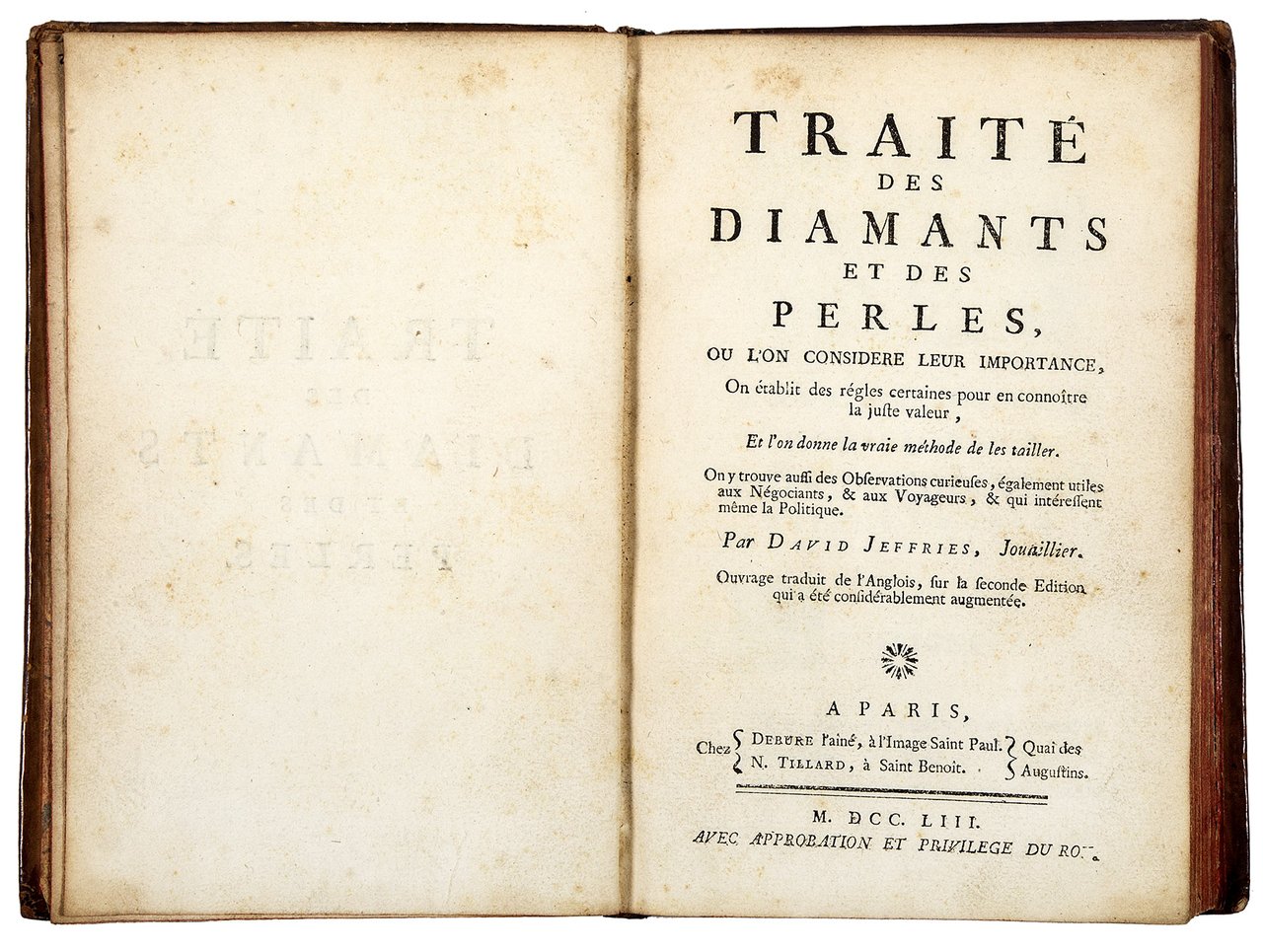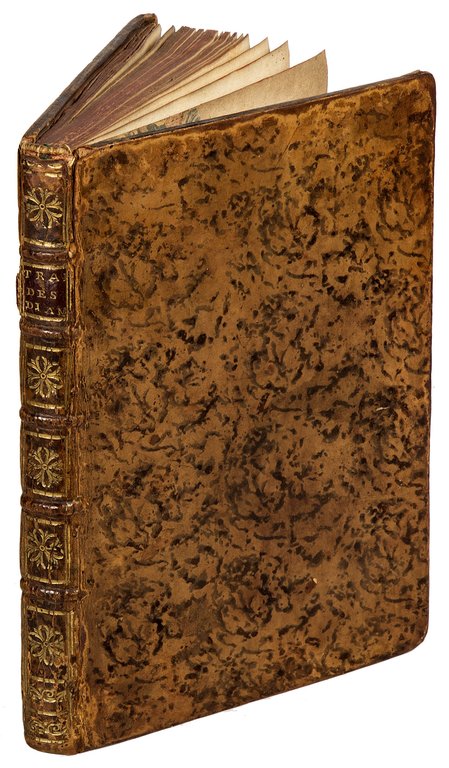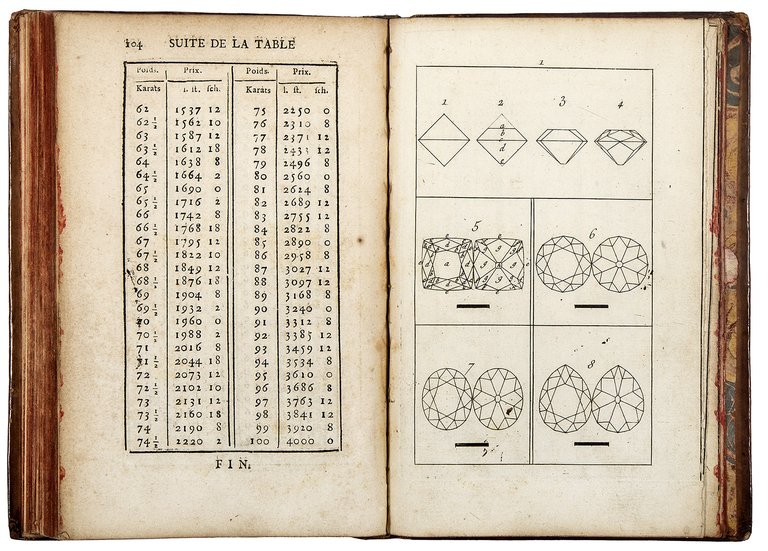


Libri antichi e moderni
JEFFRIES, David (fl. metà del XVIII sec.)
Traité des diamants et des perles, où l'on considère leur importance, on établit des règles certaines pour en connoître la juste valeur, et l'on donne la vraie méthode de les tailler. On y trouve aussi des observations curieuses, également utiles aux négociants, et aux voyageurs, & qui intéressent même la politique
Debure l''aîné e N. Tillard [Debure l''aîné e N. Tillard], 1753
900,00 €
Govi Libreria Antiquaria
(Modena, Italia)
Le corrette spese di spedizione vengono calcolate una volta inserito l’indirizzo di spedizione durante la creazione dell’ordine. A discrezione del Venditore sono disponibili una o più modalità di consegna: Standard, Express, Economy, Ritiro in negozio.
Condizioni di spedizione della Libreria:
Per prodotti con prezzo superiore a 300€ è possibile richiedere un piano rateale a Maremagnum. È possibile effettuare il pagamento con Carta del Docente, 18App, Pubblica Amministrazione.
I tempi di evasione sono stimati in base ai tempi di spedizione della libreria e di consegna da parte del vettore. In caso di fermo doganale, si potrebbero verificare dei ritardi nella consegna. Gli eventuali oneri doganali sono a carico del destinatario.
Clicca per maggiori informazioniMetodi di Pagamento
- PayPal
- Carta di Credito
- Bonifico Bancario
-
-
Scopri come utilizzare
il tuo bonus Carta del Docente -
Scopri come utilizzare
il tuo bonus 18App
Dettagli
Descrizione
PRIMA EDIZIONE IN FRANCESE, dedicata al Principe di Condé, del fortunato Treatise on Diamonds and Pearls del gioielliere inglese David Jeffries nella traduzione realizzata da Chappotin S. Laurent della Bibliothèque Royale sulla seconda edizione inglese aumentata e corretta (London, 1751). Rispetto alla prima edizione dell'anno precedente, alla seconda edizione furono infatti aggiunte sezioni sui diamanti brasiliani, su metodi alternativi di valutazione e sul taglio indiano.
“The first book in English to describe how diamonds and pearls can be evaluated on the basis of the factors of size (or weight) and style of cut, with allowances being made in the case of diamonds where cut stones depart from the ‘ideal' proportions that were accepted as standard in Jeffries' time. These proportions are radically different from those now considered acceptable because they were based less on the production of maximum brilliance than on retention of the greatest amount of weight from the cutting of a typical octahedral diamond crystal. The ‘ideal' cut in Jeffries' time is a cushion brilliant, ‘old mine' cut, with the pavilion much deeper than employed in modern stones. The proportions and facet patterns are shown in the figures on Plate 1 and others following. Also shown are rose cut gems, graduated as before according to size and weight. The text explains the cutting procedure, how the evaluation rules were derived, the importance of imperfections and flaws as affecting price, notes on rough diamonds, previous authors who attempted to establish valuation rules, and finally, a somewhat similar procedure for the valuation of pearls, with highest values accorded to pearls of closest approach to spherical perfection, luster, etc.... Being understandable in its explanations and providing accurate tables, this work immediately won acclaim” (J. Sinkanskas, Gemology, an annotated bibliography, London, 1993, nr. 3195 per la prima edizione).
“An example of a book that is of both artifactual and intellectual value to jewelry historians is David Jeffries' A Treatise on Diamonds and Pearls written and published in 1750, which describes the commercial aspects of cut diamonds, establishing guidelines for evaluating, pricing, and defining diamond cutting styles. This book is thought to be one of the first books to discuss these topics, and it is listed as a source by many of the authors of the early books found in the core bibliography” (Ch. De Bow Klein, Jewelry History: A Core Bibliography in Support of Preservation, Washington, 1992).
Brunet, III, 526; Sinkanskas, op. cit., nr. 3198; Catalogo unico, IT\ICCU\RMRE\000847.

